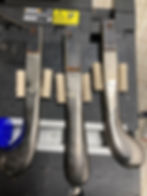Lyre Lyre
- carlinpiano
- Mar 18, 2023
- 3 min read
Updated: Jun 17, 2023

On grand pianos, the lyre is the structure that holds the pedals in place and connects them to the rods and levers that operate the dampers, sostenuto, and shift (or una corda) functions. On some grand pianos, particularly those that are older or that have had heavy use, the lyres begin to come apart and deteriorate in a number of ways.
I recently had a great opportunity to work on a lyre. Our goal was not to make the lyre look beautiful, but rather to make it function well: to allow the pianist to use each of the three pedals to make beautiful music.

As I tuned this grand piano, and as I watched the owner play it, I noticed that the entire lyre structure was moving downward as the pedals were being depressed. I also noticed that some of the wood joints were completely separated. For example, the left vertical column of the lyre is separated from the pedal box at the base of the column, exposing a visible gap.

Another issue was that the vertical metal pedal rods were not being held in their proper places because the horizontal wooden support guide was entirely separated from the vertical wooden columns. The owner and I decided that I was not going to spend any time making the lyre "pretty." The goal was to make it strong and functional.

On this lyre, each of the two vertical columns were connected to the top horizontal piece (the "capital") by nothing more than a metal pin. Those pins were subjected to too much downward force. Not only did those pins need to hold up the entire mass of the lyre, they also needed to withstand the downward force of the pedals being depressed. I removed the pins, drilled holes that went through the capital and the vertical columns, and pushed dowel rods through the holes. I then glued the entire lyre back together with slow-curing wood glue, and added some epoxy to connect and strengthen a pre-existing fracture in one of the columns.

While the glue and epoxy were curing, I disassembled the pedal box. I removed some surface rust from the pedals with a wire brush wheel on a bench grinder. In this pedal box, the pedals pivoted on metal pins in wooden dowels. Through age and use, some of the dowels were cracked, and the holes for the metal pins were enlarged, creating undesired looseness in the pedal movement. I wanted to tighten up that system and make the pedals move freely but without unwanted movement.

I cut new dowel pieces to size, drilled new holes for the metal pins, and set the pedals back into the pedal box with the new dowels. The pedals were now free of surface rust, and moving freely yet firmly into their correct positions.

Lyres withstand a substantial amount of force, in both the downward and rearward directions, from the point of view of the pianist. As the pianist depresses a pedal, the force tends to push the lyre downward but also away from the the pianist and towards the back of the piano. It's crucial to have a strong and well-fitting support to counteract that rearward force. Lyre support braces do just that.

On some pianos, the lyre support braces are metal, but on this piano,the braces were wooden. The braces were loose, which meant that they weren't doing a good job of countering the rearward force on the lyre. This meant that with each use of any pedal, the lyre was rocking in a rearward direction.

I decided to install lyre support screws to make the lyre support braces adjustable so that the braces will always fit just right, and will provide just the right support to the lyre to keep it from rocking backwards.

I re-installed the lyre in the piano, adjusted the lyre support braces so that they provided appropriate support to the lyre, and adjusted the pedal rods so that the functions of the pedals - damper lift, sostenuto, and shift (una corda) - worked properly.
Now we have a rock solid lyre that should withstand the rigors of piano playing for many years to come. This lyre might not win any beauty contests, but it will support pianists in making beautiful music.

